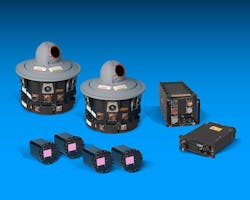Navy orders weapon assemblies for LAIRCM missile-defense systems to defend against infrared-guided missiles
PATUXENT RIVER NAS, Md. – Aircraft missile-defense experts at Northrop Grumman Corp. will provide electronic parts necessary to build and maintain laser defense systems to protect large military aircraft from infrared heat-seeking missiles.
Officials of the Naval Air Systems Command at Patuxent River Naval Air Station, Md., have announced a $92 million order to the Northrop Grumman Mission Systems segment in Rolling Meadows, Ill., to procure the necessary replaceable weapon assemblies, systems engineering technical support, analysis, and studies to integrate the Large Aircraft Infrared Countermeasures (LAIRCM) system onto aircraft for the U.S. Navy, Air Force, and the government of Australia.
LAIRCM automatically detects a missile launch, determines if it is a threat, and activates a high-intensity laser-based countermeasure system to track and defeat the missile, Northrop Grumman officials say.
The order involves:
-- 297 advanced threat warning sensors;
-- 64 control indicator unit replaceable replacements;
-- 78 Department of the Navy Large Aircraft Infrared Countermeasure (LAIRCM) processor units;
-- 52 Guardian laser transmitter assemblies (GLTAs);
-- 52 GLTA shipping containers;
-- 150 high capacity cards;
-- 79 large aircraft system processor replacement smart connector assemblies;
-- 23 personal computer memory international association cards;
-- 97 battery kits;
-- systems engineering;
-- technical support; and
-- analysis and studies to support integrating the Navy LAIRCM system onto various U.S. Navy, Marine Corps, Army, and Air Force special operations.
LAIRCM is for large aircraft like the U.S. Navy P-8A Poseidon maritime patrol jet and the Marine Corps CH-53 Super Stallion large helicopter. LAIRCM also can go aboard the U.S. Air Force C-5, C-17, C-37, and C-40 cargo and utility jets; C-130H and MC-130W four-engine utility turboprop aircraft, the CV-22 tiltrotor aircraft, and the KC-46 aerial refueling jet.
LAIRCM focuses its high-intensity laser energy at the infrared seeker head of incoming missiles to blind the missile and force it off its target. The system is designed to protect large aircraft from shoulder-fired, vehicle-launched, and other infrared-guided missiles when the planes are operating close to the ground, such as during takeoffs, landings, and low-level operations like aerial refueling.
Initial LAIRCM systems equipped C-17 and C-130 aircraft as a stop-gap measure, using an ultraviolet sensor, a countermeasure processor, and a small laser turret assembly.
Later-model LAIRCM systems use a smaller laser turret, and operate in the infrared region. Compared to first-phase LAIRCM systems, the newer models provide better resolution, better performance in optical clutter, and increased range of detection.
In the future military leaders are trying to develop aircraft-protection infrared countermeasures able to detect and classify incoming missiles, then emit a custom jamming energy to defeat them.
On this order Northrop Grumman will do the work in Rolling Meadows, Ill.; Goleta, Calif.; Longmont, Colo.; Apopka, Fla.; Blacksburg and Ashburn, Va.; Boulder Colo.; Carlsbad, Calif.; Verona, Wis.; Ashburn, Virginia (2%); Salt Lake City; and Tripp City, Ohio, and should be finished by February 2025.
For more information contact Northrop Grumman Mission Systems online at www.northropgrumman.com, or Naval Air Systems Command at www.navair.navy.mil.
About the Author
John Keller
Editor-in-Chief
John Keller is the Editor-in-Chief, Military & Aerospace Electronics Magazine--provides extensive coverage and analysis of enabling electronics and optoelectronic technologies in military, space and commercial aviation applications. John has been a member of the Military & Aerospace Electronics staff since 1989 and chief editor since 1995.
